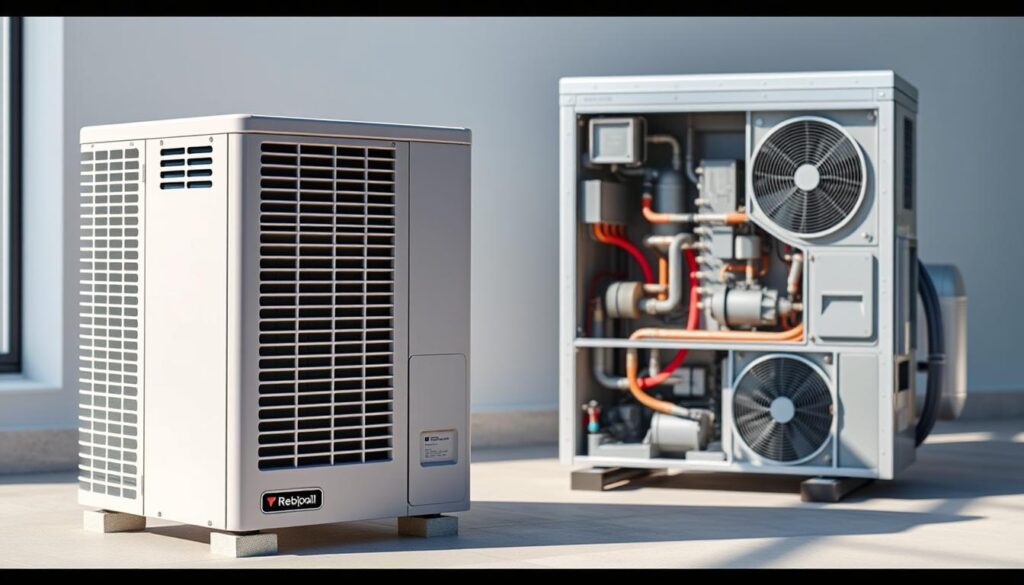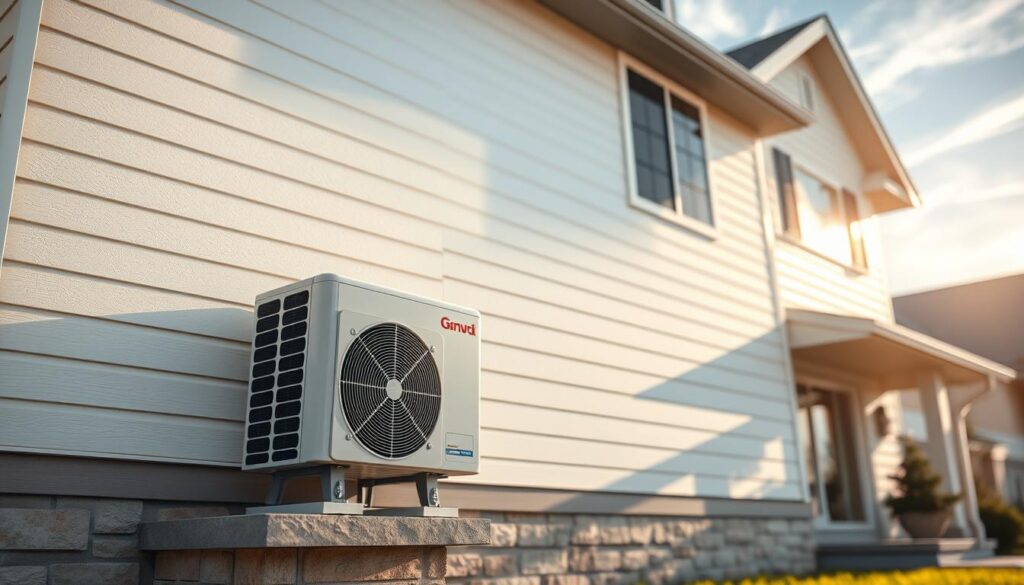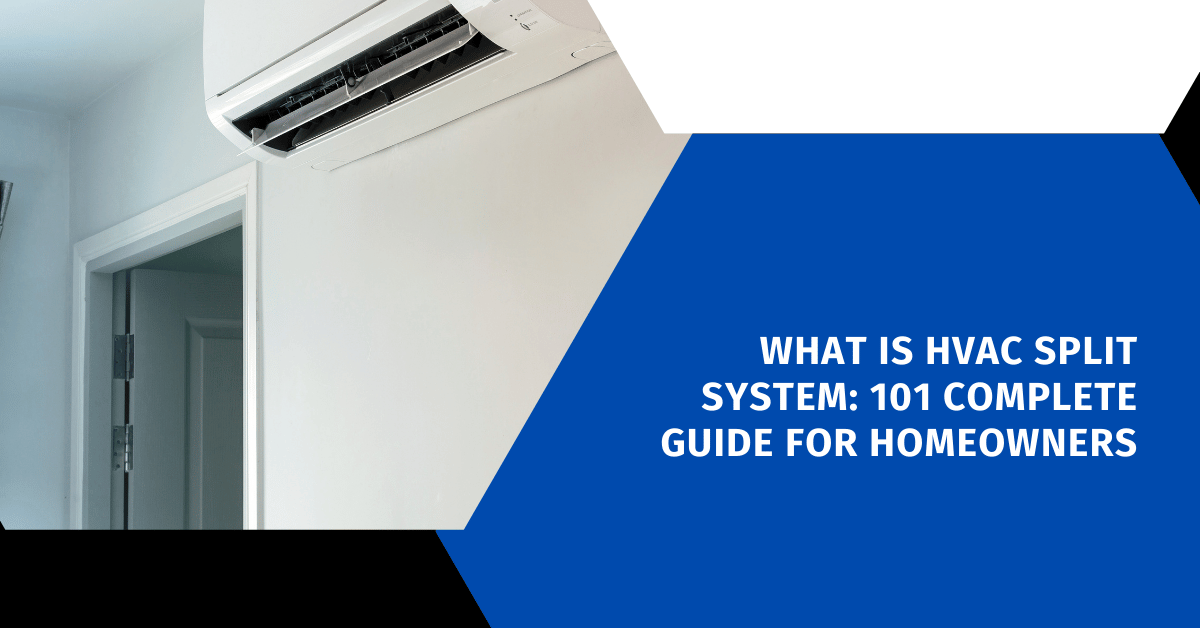Affiliate Disclosure
HVAC Guide Guys is a participant in the Amazon Services LLC Associates Program, an affiliate advertising program designed to provide a means for sites to earn advertising fees by advertising and linking to Amazon.
What Is HVAC Split System? Are you fed up with uneven home temperatures and high energy bills? The HVAC split system could be what you need. It’s a new way to control your home’s comfort, unlike old heating and cooling systems.

A split HVAC system is a modern way to cool and heat your home. It has parts inside and outside. This setup lets you control the temperature better and use less energy.
By separating the compressor and condenser from the indoor unit, it works smoothly. This makes your home comfortable all the time.
These systems are getting more popular in homes because they’re flexible and work well. They’re great for cooling one room or the whole house. A split HVAC system meets your comfort needs in many ways.
Key Takeaways
- Split HVAC systems offer more flexible temperature control
- Improved energy efficiency compared to traditional systems
- Ideal for homes without existing ductwork
- Quieter operation than conventional HVAC units
- Potential for zoned temperature management
Table of Contents
Understanding HVAC Split Systems: Basic Components and Operation
Residential HVAC split units are advanced systems for cooling and heating your home. They have two main parts that work together to control indoor temperatures. Knowing how these units interact helps you understand the technology that keeps your home comfortable.
A residential HVAC split unit is more than a simple cooling device. It’s a complex system with parts that work together to control your home’s climate.
Indoor Unit Components
The indoor HVAC unit is key in controlling your home’s temperature. It includes:
- Evaporator coil for heat absorption
- Air handler for circulating conditioned air
- Expansion valve for refrigerant control
- Air filter to improve indoor air quality
Outdoor Unit Components
Your outdoor HVAC unit is also vital in the system’s operation. It has:
- Compressor for refrigerant compression
- Condenser coil for heat release
- Fan to dissipate heat efficiently
- Protective metal casing
How Split Systems Transfer Heat
Split systems move heat through a refrigeration cycle. Refrigerant moves between indoor and outdoor units. It absorbs heat indoors in summer and releases it outside in winter. This cycle makes your HVAC split unit efficient for both cooling and heating.
What Is HVAC Split System: Core Functions and Features
A central air conditioning split system is a versatile heating and cooling solution. It goes beyond traditional HVAC methods. These systems let you manage your home’s climate with precision and efficiency.
The core functions of a heat pump split system focus on smart temperature control. Unlike old systems, these units can work with different indoor parts such as:
- Gas furnaces
- Fan coils
- Air handlers
Your split system can fit various home layouts and climate needs. The standout features include:
- Zone Control: Set different temperatures in your home’s areas
- Smart thermostat integration
- Energy-efficient operation
| System Type | Indoor Unit | Primary Function |
|---|---|---|
| Central Air Conditioning Split System | Evaporator Coil | Cooling |
| Heat Pump Split System | Fan Coil | Heating and Cooling |
Modern split systems change how we enjoy indoor comfort. They offer unmatched control and efficiency for your home.
Types of Split HVAC Systems for Residential Use
Choosing the right split system for your home can greatly improve comfort and energy use. Different ductless mini split systems meet various cooling and heating needs.
- Split system heat pump
- Traditional split system air conditioners
- Ductless mini-split systems
Split System Heat Pump
A heat pump split system is great for controlling temperature all year. It can heat and cool your home, saving energy and keeping it comfy.
“Heat pump split systems offer incredible flexibility for homeowners seeking complete climate control.” – HVAC Expert
Split System Air Conditioners
Traditional split system air conditioners cool your home in summer. They move heat outside, making your home cool and comfy.
Ductless mini-split Options
Ductless mini-split systems are very flexible for many homes. They let you control temperature in different zones without big ductwork. They’re ideal for:
- Homes without ducts
- Room additions
- Extra cooling in certain spots
When picking a heat pump or ductless mini-split, think about your home’s layout, insulation, and climate. This helps get the most efficiency and comfort.
Benefits of Installing a Split System HVAC

Choosing a residential HVAC split unit brings many benefits. It’s more than just cooling your home. It offers comfort and efficiency for today’s homes.
The energy efficient split hvac technology has many advantages. It’s perfect for those looking for smart home solutions:
- Customized Zone Control: Allows you to set different temperatures for individual rooms
- Dramatically reduced energy consumption
- Quiet operational performance
- Enhanced indoor air quality
- Flexible installation options
One big plus of residential hvac split units is saving energy. They can cut cooling costs by up to 30% compared to old central air systems. This is because they manage temperature precisely, which means lower bills.
Split system air conditioners also let you control comfort in different areas. You can cool only the rooms you’re using. This saves energy and is smart for today’s homes.
“Split HVAC systems represent the future of home climate control, with unmatched efficiency and comfort.” – HVAC Technology Magazine
Getting an energy efficient split hvac system does more than just make your home comfortable. It’s a smart choice that saves money and helps the environment for years.
Energy Efficiency and Cost Savings
Understanding the efficiency and cost savings of an energy efficient split HVAC system is key for homeowners. The cost of installation can vary. But, the long-term benefits often make up for the initial cost.
Modern split systems use advanced technologies. They work to use less electricity while keeping your home comfortable.
SEER Ratings Explained
SEER (Seasonal Energy Efficiency Ratio) shows how well an HVAC system cools. Higher ratings mean better performance:
- Ratings usually range from 13 to 21 SEER
- 21 SEER systems are the most energy efficient
- Every point increase cuts energy use by about 10%
Long-term Operating Costs
| SEER Rating | Estimated Annual Savings |
|---|---|
| 13 SEER | Baseline |
| 16 SEER | $100-$200 |
| 21 SEER | $250-$400 |
Energy-Saving Features
Energy efficient split HVAC systems have special features to save electricity:
- Variable-speed compressors
- Programmable smart thermostats
- Zoned cooling capabilities
Choosing a high-efficiency split system can greatly lower your energy bills. It also ensures better home comfort.
Split System Installation Requirements and Considerations

Installing a residential hvac split unit needs careful planning and expert help. The cost of your split system installation depends on several important factors. These factors need careful thought before starting the installation.
Before starting a split system installation, you must consider several key elements:
- Precise indoor and outdoor unit placement
- Electrical circuit compatibility
- Structural mounting requirements
- Refrigerant line routing
- Proper clearance measurements
Experts suggest specific guidelines for the best performance. Your outdoor unit needs good ventilation and protection from sunlight. Indoor units should be mounted high on walls, away from heat sources or obstructions.
Electrical considerations are very important. Most split system installations need a dedicated circuit with the right voltage and amperage. Sometimes, homes need electrical panel upgrades for the new HVAC system. This can affect your overall split system installation cost.
Important installation steps include:
- Conducting a thorough home assessment
- Determining precise unit sizing
- Preparing mounting surfaces
- Installing refrigerant lines
- Connecting electrical components
- Performing system calibration
While DIY fans might want to try installation, professional technicians are best. They ensure the system meets codes, keeps warranties valid, and works at its best for your residential hvac split unit.
Maintenance and Care for Split HVAC Systems
Keeping your split HVAC system in top shape is key. Regular care extends its life and boosts performance. It also saves energy. Knowing how to maintain your system helps avoid expensive fixes and keeps your home comfy.
Looking after your split ac system needs both DIY efforts and pro help. A structured maintenance plan keeps your system running smoothly.
Regular Maintenance Schedule
Having a solid maintenance plan is vital. Here’s a suggested schedule:
- Monthly: Clean or replace air filters
- Quarterly: Inspect outdoor unit and clear surrounding area
- Annually: Professional check of the whole system
Common Maintenance Tasks
Homeowners can handle some key tasks:
- Filter Cleaning: Change filters every 1-2 months
- Check outdoor unit for debris and growth
- Look for damage on refrigerant lines
- Clean the external unit gently
Professional Service Requirements
While DIY tasks are helpful, pro services are essential. Certified HVAC techs can:
- Do detailed system checks
- Check refrigerant levels
- Inspect electrical connections
- Lubricate moving parts
- Verify system efficiency
Professional maintenance costs $70-$200 a year. But it saves a lot by avoiding big repairs and keeping your system efficient.
Comparing Split Systems to Other HVAC Options
When looking at heating and cooling options, it’s key to know how central air conditioning split systems compare. Ductless mini split systems have unique benefits that make them stand out from other cooling methods.
Different HVAC systems offer different levels of performance and flexibility. Let’s look at how split systems compare to other cooling solutions:
- Central Air Conditioning: Traditional central air systems need a lot of ductwork. Split systems can be installed without this complex setup.
- Window Units: Split systems cool more evenly and look better than big window air conditioners.
- Packaged Units: Split systems have indoor and outdoor units separate, which improves efficiency.
- Portable Air Conditioners: Split systems cool better and save energy in the long run.
When we look at installation, energy efficiency, and performance, split systems shine. Ductless mini split systems are great for small spaces or specific cooling needs. They let you control the temperature in each room better than traditional systems.
Selecting the right HVAC system depends on your specific home layout, budget, and cooling needs.
Cost is also important. Split systems might cost more to install at first. But, they save energy and money over time, making them a smart choice.
Sizing and Selecting the Right Split System
Choosing the right residential hvac split unit is important. Your home’s unique features are key to picking the best ductless mini split systems for you.
When picking a split system, think about your space’s cooling needs. Match them with the right unit for best performance and energy use.
Calculating Cooling Capacity
Finding the right cooling capacity is key for your hvac split unit. Follow these steps to make a smart choice:
- Measure the square footage of the area you want to cool
- Calculate BTUs (British Thermal Units) needed
- Consider room height and sun exposure
- Factor in ceiling insulation quality
Zone Planning Considerations
Zone planning is vital when choosing ductless mini split systems. Different parts of your home might need different cooling solutions.
| Room Type | Recommended BTUs | Cooling Efficiency |
|---|---|---|
| Small Bedroom | 5,000-6,000 BTUs | High |
| Living Room | 9,000-12,000 BTUs | Medium-High |
| Open Kitchen | 7,000-10,000 BTUs | Medium |
“The right split system transforms your home’s comfort while optimizing energy consumption.” – HVAC Professionals Association
Remember, precise sizing matters. A unit that’s too big wastes energy, and one that’s too small can’t keep your home cool. Talking to a pro can help you choose the best for your home’s cooling needs.
Common Problems and Troubleshooting Guide
Keeping your split ac system in good shape means knowing about common issues. Even with regular maintenance, problems can pop up and affect how well your system works.
Most split system problems fall into several key categories:
- Refrigerant Leaks: Can cause reduced cooling efficiency
- Electrical Malfunctions: Interrupt system operation
- Airflow Restrictions: Prevent proper temperature regulation
When you’re trying to figure out what’s wrong with your split system, start with some simple checks:
- Make sure your thermostat is set right
- Check your air filters for dirt and blockages
- Listen for any odd sounds when it’s running
- Look for any damage on the outdoor and indoor units
“Regular inspection can prevent 70% of possible split system breakdowns” – HVAC Professional Recommendation
Some signs you need a pro include strange noises, water leaks, uneven cooling, or if it just stops working. Experts can spot and fix problems with your split ac system that you can’t see.
If you’re not sure about your system’s performance, get a pro to check it out. Trying to fix it yourself can lead to more harm than good to your HVAC system.
Conclusion
Exploring what is HVAC split system shows a smart cooling solution for today’s homes. These units let you control temperatures in different areas, making your home more comfortable. They also save on energy bills and work well.
Choosing a split system HVAC is a wise move for your home’s climate. They cool and heat well, are quiet, and use less energy. Knowing how they work, how to install them, and how to keep them running well is key.
When picking a split system, think about what your home needs. HVAC experts can guide you in choosing the right size, place, and model. Remember, proper setup and upkeep are essential for lasting benefits and energy savings.
In the end, an HVAC split system is a smart choice for your home’s comfort and value. They use the latest tech and are designed to adapt. By learning about them, you can make better choices for your home’s climate control.

